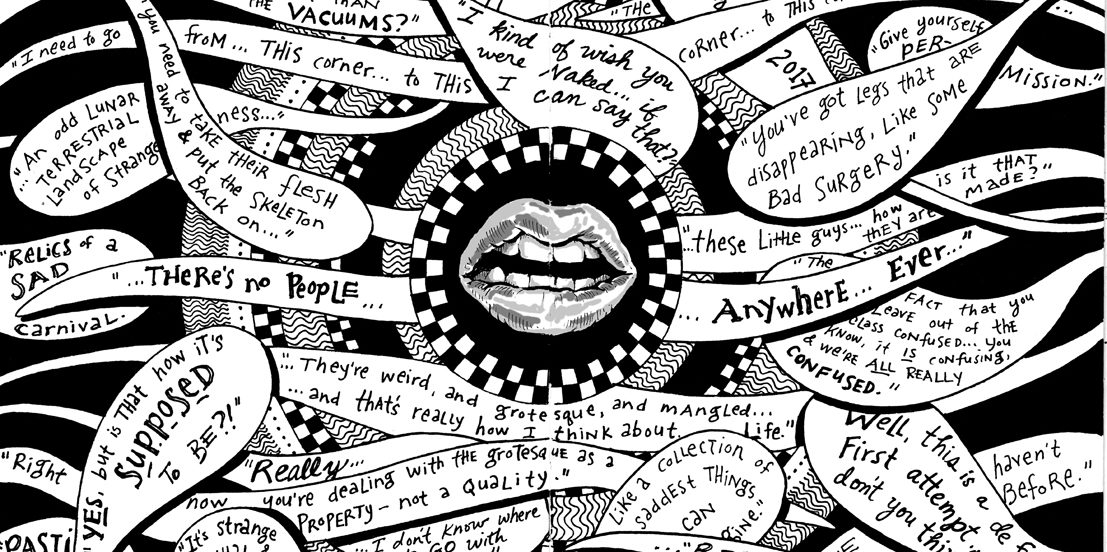Cora Lynn Deibler, Department Head of Art & Art History and Illustration Professor, discusses her latest installment of work at The Benton “Conversations”, her various expressions of art, and her experience as a Professor.
What inspired the “Conversations” piece?
In certain settings, often involving a lot of language and conversation, I found myself pulling out phrases that exist as non sequiturs and tossing them together. In that way, these phrases come together and make a story that’s not really a story. You’re left with the interrelatedness of these phrases taken out of context. You may have this desire to piece it together, but they’re really just a collection of phrases that happened throughout critiques in our graduate program. You can’t have it make sense. That’s something I really enjoy and I’ve been working with for a while. In some ways I try to represent visually the ways the language flows while you’re in those types of situations.
What is your creative process when creating a piece such as this?
When I sit and observe something like this while making a couple of sketchbook pages out of it, I don’t go in with a plan. I just kind of start to lay out where I think the text will go and then build around it. I note things down in my sketchbook in pencil first and then I go back in with black ink or white pen. There’s not much done with them digitally. This is mostly how they exist in the sketchbook. I scan the and add a little bit of value in just a few places.
You’ve had a wide range of editorial work. What is the goal of sharing more controversial art?
I have done work that’s more editorial and opinion-oriented. Anybody who works with illustration and design is trying to facilitate a conversation. Editorial work implies you have an opinion and you’re trying to communicate that; you’d like to communicate a set of specific ideas and it helps to generate a conversation around that work. It’s definitely meant to communicate to people. Some of my other art is a little more obtuse and less specific. With editorial work, you’re more likely shaping an idea and trying to communicate your thoughts a little more directly. Folks in the audience get to receive that and do with it what they will. They can have their own reaction, thoughts, and conversations about it.
As a professor, how do you feel grading students art?
I have a lot of practice with it. When you’re looking at work in the academic setting, there is a rubric even if you haven’t stated one. There are levels of mastery of the work, levels of exploration of ideas, technical aspects – there are these elements that you can evaluate. When you’re teaching, it’s those things that you’re thinking about when working with students. There’s also the element of participation – do you come to class, participate, contribute to the community in the classroom, and remain fully present? There are these other ways to evaluate the work that aren’t based on taste or differences in style. Taste and style are much more subjective things.
When you were a student, were you always doodling in your notebooks?
Yes. I think it was distracting for perhaps my teachers. I drew a lot as a kid. In the margins of textbooks and tests. My father is a musician and he would sometimes turn his sheet music to find one of my drawings. It was always something that was fun for me to do. I think people who really like to draw have to do it. You start to feel cranky when you can’t get to it.
Do you teach while creating art simultaneously?
When I’m teaching, I’m an Illustration professor. It’s what I do professionally but it’s also what I bring into the classroom. That’s why it’s important for us, as professors, to be currently making work. That’s what you bring back into your teaching. As you grow and change over the years, your work will shift as well. That is how you inform what you are doing in your classroom. If you’re not currently making work and engaging professionally, then what will you add to your teaching? Even though it’s a busy life, making work while teaching, they’re intertwined and it’s critical to remain active.
See more of Cora Lynn Deibler’s work at www.cldeibler.com



